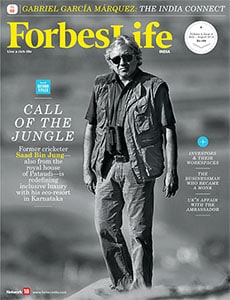Noblesse Oblige: It's Still A Thing
The concept of royalty has travelled a rough road down the ages and landed in the 21st century a little worse for wear. Far removed from the reverence, envy, and even hatred its silken robes evoked in the courts of Marie Antoinette and the Mughals, monarchy is now mocked as an irrelevance. Consider that there are probably as many museums dedicated to dinosaurs as there are to royals.

The do-gooder list is surprisingly robust.
Contributor Nirati Agarwal found several blue bloods getting their hands dirty and fighting for the greater good—Kanwar Raghavendra Singh Dundlod’s determined fight to save the Marwari breed of horse, Tripura’s Pradyot Bikram Manikya Deb Burman using his passion for sports to uplift a region and Maharaja Gaj Singh’s endeavours to improve post-traumatic healthcare for brain injuries (p 64).
For our cover story, Shravan Bhat profiled Saad Bin Jung, a former cricketer, also from the house of Pataudi. He typifies the royal who has gone from hunter to protector of wildlife. “I now realise the mistakes we made while addressing wildlife conservation within the private forests that belonged to our family,” Jung told us. “The rulers, to a large extent, permitted community usage of forest produce. Local people were asked to manage forest land, but were banned from hunting. That was the sole prerogative of the royals.” The 53-year-old is carving a different path: The luxury eco-resort set up and run by him in Kabini, Karnataka, only hires and sources locally. And, today, there are a few more big cats roaming the jungles in the Nagarhole-Bandipur belt and, for that, Jung can take a bow (p 50).
From the forests of southern India to Aracataca in Colombia, this issue also remembers literary royalty. Nina Martyris, a connoisseur of Gabriel García Márquez’s work, traced the late author’s fascinating yet under-reported connection to India. She sums it up in three pithy words: A Gandhi, a Gypsy and a Rushdie. That’s a narrative worthy of its subject (p 92).
As is the tale of the French CEO-monk who was serenely naked when Prince Mathews Thomas interviewed him. This sensational nugget aside, Christian Fabre’s story is about a life of persistent defeats that culminates in blissful enlightenment, an evocative tale of loss and recovery (p 102).
Fabre’s disenchantment with materialism can also be traced to the pressures of enterprise—and who better to talk about the fiscal treadmill than the investors and private equity players who deal with millions of dollars every day? The few Deepti Chaudhary visited, however, have effectively warded off the evil eye by keeping their family, their faith and a source of positive energy near them at work. You can see it in the mementos and keepsakes carefully positioned in their offices (p 72).
Optimism and good cheer are much sought-after companions at the workplace, as they are in life. And this issue of ForbesLife India hopes, as always, to bring some to your day.
Happy reading!
(This story appears in the July-Aug 2014 issue of ForbesLife India. To visit our Archives, click here.)
X





